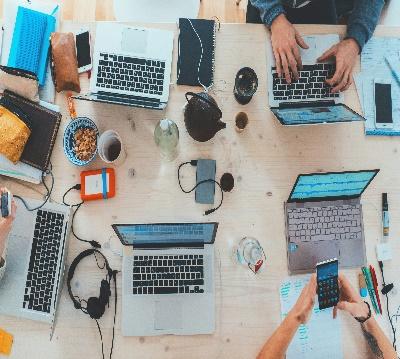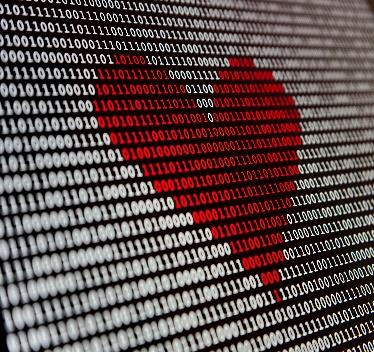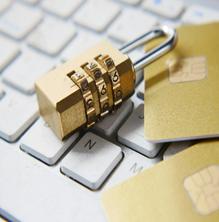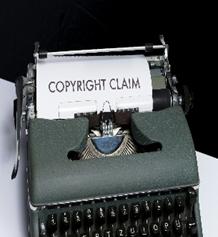Module 5
Digital fluency and essential competencies for STEM jobs
Module description
This module aims at the development of a set of knowledge, abilities and skills about how to use digital technologies to reliably achieve a desired outcome, decide when to use a specific digital technology to capture the goals set, and being able to explain why the selected technology will provide the desired results.
The acquisition of these competencies, designated by the term digital fluency, requires explicit digital knowledge, implicit digital knowledge and attainment of digital self-efficacy. The explicit digital knowledge comprises information, media and ICT literacy. In contrast, implicit digital knowledge is about making decisions, when dealing with digital technologies, drawing upon intuition and accumulated insights. Digital self-efficacy is the inner conviction of being competent at using digital technologies to achieve desired goals.
Essential for acquiring digital fluency for STEM jobs is critical thinking, creativity, ability of independent problem-solving, the collaboration capability, skills to work in a dynamic environment, ethical behavior and intercultural understanding. Like everything else, these competencies can also be trained and are the learning objectives of this module.
Development of critical thinking
Definition
Critical thinking is the process of actively and skillfully conceptualizing, applying, analyzing, synthesizing, and evaluating information to reach a conclusion or solve a problem. It involves the ability to think independently, logically, and reflectively, considering evidence and alternative perspectives before making a judgment or decision.
Key elements of critical thinking include:
- Analysis: Breaking down complex ideas or information into smaller parts to understand their structure and relationships,
- Interpretation: Understanding the meaning and significance of information, including recognizing underlying assumptions and implications,
- Inference: Drawing logical conclusions based on available evidence and reasoning rather than making unsupported assumptions,
- Explanation: Clearly articulating the reasoning behind one's conclusions or decisions, making the thought process transparent,
- Problem-solving: Applying critical thinking skills to identify, define, and solve problems effectively,
- Decision-making: Making well-informed decisions based on careful consideration of relevant factors and potential consequences,
- Creativity: Thinking creatively and generating innovative ideas while still adhering to the principles of logic and evidence,
- Reflection: Evaluating one's own thought processes and being open to revising one's beliefs in the face of new evidence or perspectives.

Source: https://unsplash.com/photos/person-catching-light-bulb-7esRPTt38nI
The importance of critical thinking
- Critical thinking plays a fundamental role in personal, academic, and professional success. It is a foundational skill that contributes to success in education, work, and life in general.
- Critical thinking involves problem analysis, break them down into manageable parts, and develop effective solutions. It is an essential skill in addressing challenges in both personal and professional life.
- Critical thinking allows a person to assess information, weigh different perspectives, and make well-informed decisions. This skill is valuable in various contexts, from everyday choices to complex decision-making in professional settings.
- People with strong critical thinking skills can express their thoughts and ideas clearly and persuasively. They are better equipped to communicate their reasoning and engage in meaningful discussions.
- Critical thinking fosters a love for learning and the ability to adapt to new information. It encourages a mindset of intellectual curiosity, continuous improvement, and openness to diverse perspectives.
- Critical thinking involves the ability to analyze information, identify patterns, and draw logical conclusions. These analytical skills are valuable in various fields, including science, business, and technology.
- Critical thinking and creativity go hand in hand. People who think critically are more likely to generate innovative ideas, find novel solutions to problems, and contribute to creative processes.
- In professional environments, critical thinking is essential for making high-quality, strategic decisions.
- Critical thinking facilitates effective conflict resolution by promoting understanding, empathy, and the ability to see issues from multiple perspectives. It encourages constructive dialogue and compromise.
- People who think critically are better equipped to conduct thorough research. They can evaluate sources, assess the reliability of information, and draw meaningful conclusions from their findings.
- Critical thinking is not only beneficial in academic and professional settings but also in everyday life. It helps people to navigate complex situations, solve problems, and make sound decisions in various aspects of life.
- .

Source: https://unsplash.com/photos/woman-leaning-against-door-while-holding-her-cheek-O-FR79xcGh8
Strategies on how to enhance your critical thinking skills:
- Embrace complex issues:
- Taking time to analyze complex issues can often lead to more robust and nuanced solutions, setting the stage for innovation and growth.
- It encourages a deeper understanding and a fresh perspective, fostering a culture of continuous learning and adaptation.
- Foster a Growth Mindset:
- Staying curious and open to new learning avenues can keep you ahead, fostering a culture that values personal and professional development.
- It promotes a proactive approach to challenges encouraging venturing beyond one's personal comfort zone.
- Challenge Prevailing Norms:
- Encouraging yourself to think outside the box can pave the way to groundbreaking solutions that redefine industry standards, fostering a culture of creativity and exploration.
- Engage in collaborative problem-solving:
- It fosters a culture of inclusivity and mutual respect.
- It encourages you to learn from each other, creating a dynamic and enriching work environment.
- Harness data wisely:
- It promotes a proactive approach to data analysis, where critical thinking is applied to interpret data effectively.
- Develop a system thinking approach:
- It encourages a broader perspective, focusing on the interconnectedness of various components.
- It nurtures an environment where you can anticipate potential challenges and effectively devise strategies to mitigate them.
- Reflect and iterate:
- It fosters a culture of accountability and learning, where mistakes are viewed as opportunities for growth and refinement, promoting a cycle of continuous improvement.
- Cultivate intellectual curiosity:
- It promotes a culture where you are encouraged to explore beyond the obvious, fostering innovation and growth.
- Allow time for thoughtful deliberation:
- It promotes a culture where decisions are well-thought-out, considering all potential outcomes and repercussions.
- It nurtures a culture of patience and foresight, where decisions are made with a long-term perspective.
- Embrace Empathy in STEM:
- It fosters a culture where the human element is considered in technological advancements, promoting a more inclusive and empathetic approach to STEM (Todd McLees, 2023).
Development of digital creativity and innovation
The contemporary era, known as the digital age, denotes the widespread use of machines and computers for the dissemination of information. This epoch has profoundly influenced our societies and daily routines, presenting both advantages and disadvantages, ushering in numerous opportunities along with associated costs.
In this age, digital technology professionals relentlessly strive to advance technology beyond conventional boundaries, pushing the limits of our imagination. The digital realm has redefined technology, transforming it into a multifaceted mode for expression, interaction, entertainment, learning, and etc. The simplicity embedded in the use of digital devices, encompassing activities from texting to sending and receiving multimedia, making video calls, and hosting myriad other functions, has reshaped our daily existence.
The transformative power of these devices lies in their capacity to enable multitasking effortlessly. While humans may not execute multitasking with the precision of computers, they possess the unique capability to allocate individual attention to each task.
A pivotal aspect of these digital devices for humans is their memory, which has experienced remarkable expansion in both speed and efficiency. This digital memory serves as a repository for storing critical secrets, important business documents, and cherished pictures. Beyond its fidelity, the digital memory's capacity to retain information for extended periods, as long as it resides within our devices and remains inaccessible without permission, is invaluable. Professionals in memory engineering have contributed significantly to simplifying our lives by continually enhancing digital memory. This innovation allows us to eschew the traditional methods of storing information in our minds or on paper; instead, we entrust them to our digital devices, carrying this stored information effortlessly wherever we go, free from concerns about their security and accessibility.
The existing conceptualization of digital creativity is articulated as ‘‘all forms of creativity driven by digital technologies’’ (Lee, 2013). Essentially, digital creativity takes place when creative pursuits involve the utilization of digital devices. Nevertheless, as of now, the extent, viewpoint, and primary research foci in the realm of digital creativity remain ambiguous.
Digital creativity stands as a dynamic and expanding field, brimming with considerable potential. The technologies associated with digital creativity actively support a diverse range of artistic expressions in digital formats, including text, layout, images, sound, 3D objects, and moving images. These technologies not only empower the creation of such representations but also facilitate their capture, storage, manipulation, and output, resulting in the production of immersive media experiences. The synergy between the foundational representational form and technological processing serves as the cornerstone for the convergence observed in digital creativity.

Source: https://unsplash.com/photos/a-group-of-women-standing-around-a-white-board-pNodosEZ5Oc
Strategies on how to improve your digital creativity and innovation skills
- Don’t stop to learn. Stay updated with the latest trends, technologies, and advancements in your field of interest. This could involve taking online courses or attending webinars, reading scientific publications.
- Engage with individuals from diverse backgrounds and industries to expose yourself to a range of perspectives. This can help you to find innovative ideas and problem-solving approaches.
- Implement a problem-solving strategy rooted in design thinking, which involves empathizing with users, identifying problems, brainstorming potential solutions, creating prototypes, and iteratively testing them.
- Embrace experimentation with novel tools, techniques, and ideas without fear. Rapidly develop prototypes to assess your concepts and collect feedback, enabling refinement and enhancement of your innovations.
- Engage with colleagues, mentors, and industry experts to share insights and ideas, fostering collaboration. Networking may also yield potential partnerships and innovative project opportunities.
- Immerse yourself in sources of inspiration like literature, art, music, and the natural world. Such an environment can ignite creativity and facilitate the generation of innovative ideas.
- Allocate consistent periods in your schedule for creative pursuits like brainstorming, idea generation, and exploration.
- Recognize that failure is intrinsic to the creative journey. Invite others to review your ongoing work and embrace constructive criticism. This feedback offers invaluable insights and viewpoints, aiding in the enhancement and polishing of your creative endeavours.
Development of digital collaboration and communication skills
Workplace collaboration is the synergistic effort of individuals working together to achieve a common goal, offering an alternative perspective to the concept of teamwork. The approach to collaboration can vary, depending on the nature of the project. Effectively collaborating involves the sharing of ideas and discussions to determine the most suitable approach, enhancing the overall efficiency of the process.
The internet played a pivotal role in this shift, providing a platform for easy and convenient information sharing, irrespective of physical locations. This provides a unique opportunity for cross-cultural exchange and learning which not only enhances understanding of diversity but also prepares to work in a globalized and interconnected world.
Here are a few examples of online collaboration tools tailored to the specific needs of STEM professionals, helping them to work more efficiently, share knowledge, and collaborate effectively on scientific research, engineering projects, and educational activities.
- GitHub serves as a widely adopted version control platform, catering to the collaborative needs of developers and researchers alike. It facilitates teamwork on coding projects, code sharing, change tracking, and software development workflow management.
- LabArchives stands as an electronic lab notebook solution meticulously crafted for researchers, enabling them to securely organize, store, and exchange laboratory data, experimental records, protocols, and research outcomes over the internet.
- Figshare functions as a repository platform utilized by researchers for the publication, dissemination, and exploration of research outputs. This encompasses datasets, figures, posters, presentations, and various other forms of scholarly content.
- Slack is a renowned platform for team communication and finds extensive utilization among STEM teams for instant messaging, file exchange, collaborative efforts, and seamless integration with other tools and services pertinent to their endeavors.
- Jupyter Notebooks, an open-source web application, is employed by researchers and data scientists to craft and distribute documents featuring live code, equations, visualizations, and explanatory text. This fosters collaborative efforts in data analysis and computational research.
- Google Workspace provides collaborative tools like Google Drive, Docs, Sheets, and Slides, extensively utilized by students in STEM disciplines. These tools facilitate the creation, sharing, and joint work on documents, spreadsheets, presentations, and assignments.

Source: https://unsplash.com/photos/pencils-and-smartphone-on-top-of-books-nJdwUHmaY8A
Digital ethics code
Nowadays people communicate, acquire knowledge, share information, bank and trade predominately using digital technologies and Internet. In this virtual world the individual rights and societal interests are regulated by the Digital Ethics Code (also called information ethics), which fundamental principles originate from the Universal Declaration of Human Rights.
Historically, the philosopher Mario Bunge and the American priest and teacher of Philosophy, Theology and Ethics, Norman Faramelli highlighted for the first time the need to develop ethics as a branch of technology. In the ancient, Plato and Aristotle acknowledged that technological progress in the arts and engineering will raise new moral dilemmas. The phrase information ethics was first used in 1988 by Robert Hauptman in the book “Ethical challenges in librarianship” and in a scientific report from Rafael Capurro published in “Nachrichten für Dokumentation”.
The information ethics cover a wide range of moral, legal and societal issues that concern the application of Information and Communication Technologies including freedom of expression, access to information and education, data protection, privacy and identity, copyright and fair use, ethical implications of artificial intelligence and automation, etc.






Source: https://unsplash.com/photos/mans-hand-and-chains-zh0J32MrJfA;
https://unsplash.com/photos/people-sitting-down-near-table-with-assorted-laptop-computers-SYTO3xs06fU; https://unsplash.com/photos/i-love-you-heart-with-i-love-you-text-xZcWyykjZ6I; https://unsplash.com/photos/a-golden-padlock-sitting-on-top-of-a-keyboard-FnA5pAzqhMM; https://unsplash.com/photos/green-and-white-braille-typewriter-9XfSFjcwGh0; https://unsplash.com/photos/robot-playing-piano-U3sOwViXhkY
On the 25 January 2022, the European Commission published the European Declaration on Digital Rights and Principles for the Digital Decade. The document gathers all existing principles and rights that will guide the digital transformation in the EU and gives everyone a clear reference point about how to behave digitally ethical. The EU’s idea of a fair and ethical digital environment puts people at the center of the digital transformation, supports solidarity and inclusion, ensures the freedom of choice online, fosters participation in the digital public space, requires safety, security and empowerment of individuals, and promotes sustainable digital future.
Beside an etiquette for the inter-personal norms in the digital world, companies have declared the need of regulatory frameworks to guide digital ethics challenges arising at specific businesses and help them to build trust with customers and corporative partners. As a result, many firms have started to develop approaches to anticipate and manage the ethical issues emerging in the area of their activity, for example, in the manufacture, sale, and distribution of genome editing technology products, by the integration and exchange of large amounts of highly sensitive patient data, development of artificial intelligence powered devices etc. In 2021, Merck KGaA, Germany, published a code of digital ethics that should govern company policy in the development, commercialization and utilization of digital products and processes. The five core principles on which it is based are: autonomy, justice, beneficence, non-maleficence and transparency.
Deutsche Telekom, SAP or Telefónica are other examples of companies who have developed practical ethical guidelines concerning handling data and algorithmic systems. In November 2021, UNESCO produced the first-ever global standard on AI ethics – the Recommendation on the Ethics of Artificial Intelligence, which was adopted by all 193 Member States. Central to this framework is the creation of AI systems that work for the good of humanity, individuals, societies and the environment. It provides also extensive policy action areas, which allow policymakers to translate the core ethical principles into action with respect to data governance, environment and ecosystems, gender, education and research, and health and social wellbeing, among many other spheres. On 13.03.2024 the EU has passed the World’s First Comprehensive AI Law, which aims to protect fundamental rights, democracy, the rule of law and environmental sustainability from high-risk AI, while boosting innovation.
From the brief overview above on what is information ethics, it is seen, that there are several documents regulated at various levels the human acceptable behavior in the digital world. Being familiar with all of them is neither possible nor necessary as basic moral values as honesty, responsibility, fairness, tolerance, justice, peacefulness, empathy and loyalty lay the foundation to each of them. “Ethics comes before, during and after the law”, said Giovanni Buttarelli, European Data Protection Supervisor. The sentence “Treat people online the way you would treat them in real life, and the way you would want to be treated“ used on many websites, somewhat rephrased, describes in plain language how to practise digital ethics.
For women working in STEM, especially for those involved in the research and technology development, the responsible and faire digital behavior requires knowledge in the field of the intellectual property rights, data security and privacy. Skills related to protection of scientific results or developments from exploitation by third parties without given consent, proper use of images, illustrations, tables, etc. produced by others, writing a data availability statement or addendum to a publication agreement, proper citation of sources, are important to practice the digital ethical standards. However, prior to this crucial step, extensive experimentation, data processing, and storage are typically conducted using modern computing devices.
Software solutions helping researchers to protect their results on this age of development of a new product or technology from unauthorized access, sharing or content changes represent the Access Control and Data Loss Prevention (DLP) systems. There are numerous DLP tools on the market, some examples running on Windows, macOS, and Linux are Forta Digital Guardian, Co So Sys Endpoint Protector and CrowdStrike Falcon Device Control. As the use of such IT products is more commonly limited in enterprise environments, due to their price and some other restrictions, files encryption remains the most common technique used by students and academic to safeguard their work. PDF filles, word and excel documents can be protected with a password, water mark/certificate or digital signature.
Restrict Access settings enable to grant permission for only read the document or read, edit, and save changes to the file without option to print it. Enhanced security settings provide a way to specify locations for trusted content. These privileged locations can be single files, folders, or host domains (root URLs). Content that resides in a privileged location is trusted. For example, enhanced security normally blocks PDFs from loading data from unknown websites. Emails can also be encrypted and send secure. With a few simple steps everyone, even no a security expert, can secure your computer. These include: Installation and running of anti-virus software to detect and remove malware, back up computer’s data to protect data loss, use of firewall to prevent unauthorized access, setting computer password to prevent others from logging in, regularly updating of computer's software and firmware to protect against the newest vulnerabilities, automatically computer locking after inactivity.
Data protection is not only important to ensure that honors and financial benefits from an innovation or discovery will not go to third parties. In the context of the digital ethical responsibility, it raises also questions like: If the generated research results fell into the hands of malevolent individuals, what would happen? Can they be used to harm humans, animals or the environment? What would happen if they are modified and could they serve other purposes than the intended applications? Proper data protection is also a legal obligation to ensure the security of individuals' data. The data privacy rights of the EU citizens are protected by The General Data Protection Regulation (GDPR). GDPR gives consumers certain rights over their data while also requiring companies to comply with security measures when storing customer information. Companies operating in the European Union are required to obtain informed consent from users before collecting and using their data and to provide transparency around how that data is being used.
By development or implementation of new products and technologies companies often work together with academic organizations. As the scientific reputations are established through the publication of research results, academic usually prefer to publish them rather than patent. Companies on the other hand prefer to apply for a patent. In this context, it is very important for academic to know what they agree when sign a data availability statement required during the article submission process. The data availability statement (also sometimes called a ‘data access statement’) indicates where and under what conditions the data supporting the research results can be accessed. The authors have the opportunity to state the generated data as openly available, available upon request or not openly available. The last one makes usually the editors and reviewers sceptics and is an acceptable option when the research is of sensitive nature. The data policy of some journals enables to state ‘’Embargo on data due to commercial restrictions’’, which allows the authors to make the data supporting their findings available following a certain period of time from the date of publication.
On one hand, the statement of openly available data navigates the trust in the performed investigations verifying the manuscript credence, but, on the other hand, it takes the risk of limiting the opportunities to develop the conducted research as a new product or service, or through a startup company, and therefor to loss of future commercial benefits. In this context it is important to know that once publicly disclosed, the ability to patent research invention may be compromised due to non-compliance with the criterion of novelty. In only some very few countries (Australia for example) there is a one-year grace period after publication when researches can file a patent application. While the patent protects invitations and the trademark law words, phrases, or symbols—such as logos, slogans, and brand names used to distinguish an individual’s or corporation’s work from another entity, the copyright law protects a creator's original work from being used or duplicated without their permission.
The concept of the digital responsible behavior requires familiarization with the procedure allowing legal re-use of online published figures, illustrations, charts, tables, photographs, and text excerpts. So, how to request permissions to reuse journal article content is another important skill for STEM students and careers. As a rule, written permission must be obtained from the rightsholder, who, typically, is the publisher unless it is explicitly indicated otherwise. Usually, it can be obtained via an automated permission-granting service, RightsLink, located on the individual journal website. A general exception to this rule are the open access journals, which have different, in some cases very specific, agreements governing the re-use of materials. In this case the authors should check the journal homepage for more information on their republishing policies.
Copyright infringement includes beside using copyrighted data without permission, also the use of compromised software or unauthorized commercially available software without payment, unauthorized download of e-books and articles, the use of someone's work without giving them proper credit and citations. It is considered a professional and ethical responsibility to credit the original authors, which might sometimes not happen because of unintentionally improper citation. For correct citation and referencing of sources in a research paper the authors should became familiar with the specific requirements of the journal, usually provided in the submission guideline. There are also reference management software programs on the market as EndNote, Mendeley or Zotero that help researchers to organize and structure their sources in a whole range of journal styles with just a few clicks, which saves time and effort and improve the citations accuracy.
In certain circumstances a copyrighted work can be used without acquiring permission from the rightsholders. For purposes such as criticism, comment, news reporting, teaching (including multiple copies for classroom use), scholarship, or research the reproduction of online published materials is allowed under the concept of the fair use. Of course, it is expected that any use will be accompanied by proper authors attribution and citation.
In conclusion, best practices to ensure digital ethical behavior include:
- Understanding the concept of the digital ethical code.
- Highlighting the Human Lives and Interests behind the technology.
- Promote the values of autonomy, transparency, and trustworthiness.
- Development of ethical decision-making frameworks that guide the development and use of digital technologies.
- Implementing Data Privacy and Security measures.
- Implementation of Intellectual Property Rights.
- Training & Awareness on existing laws, regulations, policies, standards and procedures for Data Protection and Privacy.
Quizzes
Development of critical thinking
Development of digital creativity and innovation
Development of digital collaboration and communication skills
Digital ethics
Key priorities guiding the digital transformation in the EU
External resources
https://medium.com/@maleehakaleem8/introduction-f4716293b16a - What does digital age refer to?
https://doi.org/10.1016/j.chb.2014.04.001, Maria R. Lee, Tsung Teng Chen, Digital creativity: Research themes and framework, Computers in Human Behavior, 2015, 42, pp. 12-19 - What does digital creativity mean?
https://toddmclees.medium.com/10-tips-to-enhance-your-critical-thinking-skills-in-stem-careers-14b05bbe8f71 - Strategies on how to enhance your critical thinking skills
https://www.intechopen.com/chapters/63436, Mario Barajas, Frédérique Frossard and Anna Trifonova, Strategies for Digital Creative Pedagogies in Today’s Education, DOI: 10.5772/intechopen.80695 - Digital creativity definition and different approaches to the study of creativity
https://www.cambridgeinternational.org/Images/426483-chapter-4-innovation-and-creativity.pdf - Innovation and creativity
https://digitaleducation.tdm2000.org/topic/topic-3-creative-processes-for-a-digital-generation-encouraging-self-expression-and-innovation/ - Creative processes for a digital generation: encouraging self-expression and innovation
https://www.ejmste.com/download/stem-technology-based-model-helps-create-an-educational-environment-for-developing-students-12033.pdf - STEM technology-based model helps create an educational environment for developing students' technical and creative thinking
https://www.lumapps.com/employee-experience/types-of-collaboration/-Workplace collaboration
https://infinitylearn.com/surge/english/essay/digital-collaboration-in-classroom-essay/- Digital Collaboration In Classroom
https://www.flowmapp.com/blog/qa/what-are-some-examples-of-collaboration-tools - Collaboration Tools for Communication
https://eur-lex.europa.eu/legal-content/EN/TXT/?uri=OJ:JOC_2023_023_R_0001 - European Declaration on Digital Rights and Principles for the Digital Decade
https://www.merckgroup.com/en/sustainability/business-ethics/digital-ethics.html - Merck Code of Digital Ethics
https://unesdoc.unesco.org/ark:/48223/pf0000381137 - UNESCO digital Library, Recommendation on the Ethics of Artificial Intelligence
https://www.europarl.europa.eu/news/en/press-room/20240308IPR19015/artificial-intelligence-act-meps-adopt-landmark-law - Artificial Intelligence Act: MEPs adopt landmark law
https://time.com/6903563/eu-ai-act-law-aritificial-intelligence-passes/ - The AI Act
https://helpx.adobe.com/acrobat/using/enhanced-security-setting-pdfs.html - Protection of pdf files
https://support.microsoft.com/en-gb/office/protect-a-document-with-a-password-05084cc3-300d-4c1a-8416-38d3e37d6826 - Protection of world and excel filles
https://bcu.ac.in/documents/NEP/DigitalFluencyCCIG%20V%201.0_compressed.pdf
How do I secure my computer?
https://eur-lex.europa.eu/legal-content/EN/TXT/?uri=CELEX%3A02016R0679-20160504 -
The EU General Data Protection Regulation

